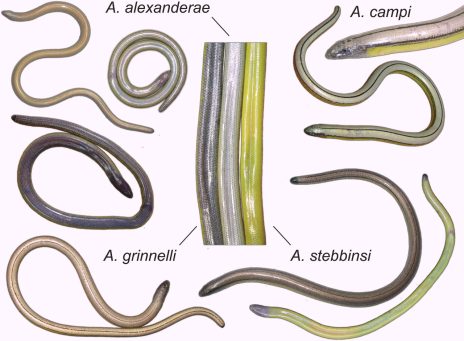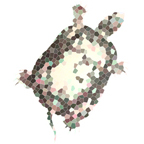Archive for category New Species
Darwin Day – Remembering the Man (and the Fish)
Posted by Matthew Bettelheim in History, Humor, New Species, Shameless Promotion on February 12, 2014
In celebration of Darwin Day, I thought it would be fun to revisit a story I originally wrote for Inkling Magazine in 2007 about Darwin fish, “Evolution’s Bumper Sticker War Against Intelligent Design“:
“In a modern world where religion often finds itself at odds with science, it’s worth keeping in mind that Charles Darwin, the father of evolution, was God’s man. After he returned from his five year voyage aboard the HMS Beagle, the Anglican naturalist struggled to reconcile his faith with his theory of evolution by natural selection. As can be expected in a world where the fittest survive, evolution won out over creationism. Today we remember Darwin’s legacy by way of a small plastic fish. A fish with legs…” [Continue Reading]
This feature article was quick to inspire Inkling Magazine‘s Your Chance to Be an Intelligent Designer contest, where readers submitted ideas for a new fish to join the pantheon of pisces that adorn dusty bumpers around the world. Overseeing the competition were judges Prophet Bobby Henderson of the Church of the Flying Spaghetti Monster, Nona Williams, co-owner of Ring of Fire Enterprises, and science blogger PZ Myers.
My own contribution to the contest was The Steve Fish, inspired by the National Center for Science Education’s Project Steve, “a tongue-in-cheek parody of a long-standing creationist tradition of amassing lists of “scientists who doubt evolution” or “scientists who dissent from Darwinism.”

But hands down, the best entry in my esteem was the Teapot Fish contributed by Patrick Quigley, in honor of the late Bertrand Russell and his famous Celestial Teapot metaphor.

I can’t recall who actually won, but in honor of the late Charles Darwin (February 12, 1809 to April 19, 1882), let’s raise a cup of tea to remember the champion of science and reason.
Breviora: Four New Species of California Legless Lizards (Anniella)
Posted by Matthew Bettelheim in Endangered Species, Herpetology, Natural History, New Species, News and Research, Silvery Legless Lizard on September 22, 2013
Writing in the September 2013 issue of the Museum of Comparative Zoology, Harvard’s Breviora, California herpetologists Theodore J. Papenfuss and James F. Parham recently took the world by storm, enchanting news outlets across the globe with their discovery and description of four new species of California legless lizards.
Until recently, this unique lizard remained a relatively unheard-of reptile species (that is, outside of the small herpetological circle of Anniella initiates or those unknowingly lucky enough to live in an area where legless lizards are so common, they show up in the garden like earthworms). Nevertheless, California legless lizards are otherwise commonplace in central and southern California with sandy, loamy soils, oak trees, and lupines. Their namesake leglessness is an adaptation to a life spent underground, where they effectively swim through sandy soils, surfacing only to feed on insects beneath the leaf litter or short bursts of aboveground dispersal. Any resemblance to snakes is passing: legless lizard have moveable eyelids, vestigial limb rudiments, and autocaudal autonomony, the ability to lose their tails like common fence lizards.
After reporting a high genetic diversity amongst California legless lizards in 2009 (see Parham and Papenfuss 2009), Papenfuss and Parham delved deeper into Anniella spp. genetics to identify the contact zones between the emerging clades and determine whether these lineages were genetically isolated enough to recognize distinct cryptic species. After reviewing museum specimens as part of their 14-year range-wide study of genetic variation, Papenfuss and Parham found that coloration, one of the major morphological characters that helps distinguish the emerging Anniella complex, went largely unreported because the markings of specimens collected and preserved in alcohol became faded and degraded. Additional field study turned up live specimens whose coloration, paired with x-ray vertebral counts, stripe width, and scale counts, corroborated the researchers’ genetic variation.

Anniella alexanderae, upper left: dorsal and ventral view showing the diagnostic gray coloration. Anniella campi, upper right: dorsal view and detail showing diagnostic double dark lateral stripes. Anniella grinnelli, lower left: ventral view showing diagnostic purple coloration and dorsal view. Anniella stebbinsi, lower right: dorsal and ventral view. Center: comparison of ventral coloration from three of the new species: A. grinnelli, left, A. alexanderae, center, and A. stebbinsi. Image credit: Theodore Papenfuss / James Parham.
Here, briefly, are the four species nova:
Anniella alexanderae, new species
Temblor Legless Lizard
Key Diagnostic Characters: light grey ventral coloration; single lateral stripe; high (>250) dorsal scale count.
Distribution: sandy soils at the southeast base of the Temblor Range between McKittrick and Taft, west side of the Southern San Joaquin Valley, Kern County, CA.
Anniella campi, new species
Southern Sierra Legless Lizard
Key Diagnostic Characters: double, dark lateral stripes.
Distribution: western edge of the Mojave Desert in Kern and Inyo County, CA.
Anniella grinnelli, new species
Bakersfield Legless Lizard
Key Diagnostic Characters: purple (grayish red) ventral coloration.
Distribution: southern San Joaquin Valley and east side of the Carrizo Plain, CA.
Anniella stebbinsi, new species
Southern California Legless Lizard
Key Diagnostic Characters: karotype (cryptic).
Distribution: throughout southern California south of the Transverse Ranges into northern Baja California, Mexico; disjunct populations in the Tehachapi and Piute mountains, Kern County, CA.
With these new species comes another well-deserved honorific by naming the southern California legless lizard Anniella stebbinsi, a tribute to esteemed herpetologist Dr. Robert C. Stebbins.
These celebrated species may vanish as quickly as they’ve appeared, however. Given how easy it is to overlook these cryptic lizards, the limited distributions of three of them – the Temblor (A. alexanderae), Southern Sierra (A. campi), and Bakersfield (A. grinnelli) legless lizards – puts them at greater risk of extinction, especially where they overlap with human habitation. Papenfuss and Parham recommend further study to better understand the range and distribution of this newly described California-endemics.
Full Citation: Papenfuss, Theodore J. and James F. Parham. 2013. Four New Species of California Legless Lizards (Anniella). Breviora: September 2013, No. 536, pp. 1-17.





